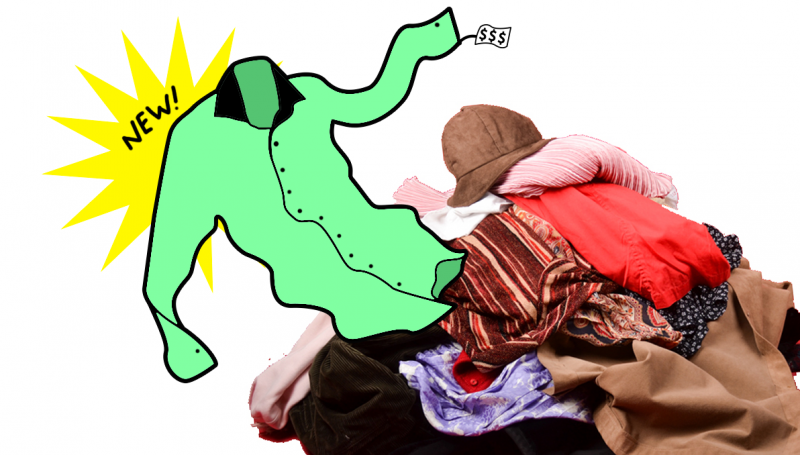We’ve all been there: your favourite celebrity wears a designer item worth more than your rent. You fawn over it and think “why aren’t I rich?” Then, as if meant to be, you see it at Zara. It’s there, it’s beautiful, it’s… $19.99? But what’s the true cost?
Fast fashion giant Forever 21 filed for bankruptcy on Sept. 30. At its peak, the company had USD$5.8 billion in revenue, according to Business Insider. What does this mean for the future of the retail industry? Does the end of Forever 21’s reign signify a new beginning?
But first, what is fast fashion, why is it problematic and why is it increasingly becoming the topic of conversation?
Fast fashion is cheap and trendy clothing produced in as quickly as two weeks – think H&M, Zara and Urban Outfitters. While they make it easy to be fashionable, fast fashion suppliers come with their own set of problems. After oil, fashion is the second most polluting industry. According to online resale marketplace thredUP’s 2019 Resale Report, 108 million tons of non-renewable resources are used every year to produce clothing.
Consumers no longer buy with the intent to keep; an increasing desire to be constantly seen in new styles is shortening the garment life cycle. Because of this, the equivalent of one garbage truck is landfilled every second.
With the ridiculously low prices comes an ethical dilemma. As per Fashion Revolution, Human rights abuse is a prominent issue: unsafe working conditions, child labour, and exploitation contribute to why garments can be purchased at such low costs. According to thredUP, 59 per cent of consumers expect retailers to create products ethically and sustainably.
Fashion Revolution is a global movement aiming to unite people and organizations to change how clothes are consumed and produced. Their goal is to achieve an environmentally conscious and ethical industry. Through their #whomademyclothes movement, they strive to encourage brands to disclose where their garments are produced and who exactly is making them. The point is to show that most fast fashion brands cannot name where their products are being made because they don’t know. Fashion Revolution hopes to push brands to be more transparent, accountable and honest about their practices.
Fashion Revolution releases a yearly Fashion Transparency Index listing data from the top 200 global fashion brands regarding how much they disclose about their business. A higher score means a more transparent brand in regards to where their garments are made, their ecological footprint, social responsibility, gender equality and payment of living wages.
Working in the fashion industry, I think about this often, and it’s something I’ve struggled with. Keeping up with trends is part of my job and marketing those trends is my job. Balancing this alongside my desire to be as sustainable, eco-conscious and ethical as possible has proven to be a dilemma. Or rather, it was a dilemma.
Finding sustainable alternatives is no longer a concern. There is an abundance of secondhand shops – curated and thrift – in Montreal. There’s a Salvation Army on Notre-Dame St. W., in downtown Montreal, with over seven racks of exclusively denim items. For a more curated selection, there are three Empire Exchange locations in Mile End, where I’ve found my fair share of designer items (Yves Saint Laurent denim shorts, anyone?).
When following trends, I felt blocked. My closet was full, yet I always seemed to have nothing to wear. I easily got bored and resorted to buying more and more. Not to mention, there was the constant guilt of not knowing who was making my clothes, but knowing they couldn’t afford decent living conditions. Having studied the supply chain in fashion school, I felt in part responsible; I had all this knowledge about fast fashion’s ramifications and wasn’t doing anything about it.
I have not stepped foot in a fast fashion retail store in over a year, and it feels like a step in the right direction. Shopping exclusively vintage, thrifting, buying goods made in Canada and supporting local designers feels incredibly rewarding. My closet may not be overflowing, but I’ve developed a distinct personal style. Adopting a sustainable lifestyle forces you to get creative, upcycle, and do-it-yourself. Not to mention, it significantly reduces your carbon footprint.
So, where is fashion headed? Forever 21’s bankruptcy wasn’t a fluke. It’s the result of changing consumer tastes and a growing resale industry. According to thredUP’s 2019 Resale Report, resale has grown 21 times faster than the retail market in the past three years. The secondhand market is expected to reach USD$68 billion by 2024, and to grow 1.5 times the size of the fast fashion industry by 2028.
“The fashion of the future is not about the pretty little things, the shoes and the handbag and new party dress,” wrote Carry Somers, founder of Fashion Revolution, in the 2019 Transparency Index. “It is about weaving truth and value into our clothing. We love fashion. We love beautiful clothes. But there is no beauty without truth and there is no truth without transparency.”
You can read Fashion Revolution’s Transparency Index and find out more about the #whomademyclothes campaign at https://www.fashionrevolution.org/.
Photo by Brittany Clarke / Graphic by @sundaeghost




